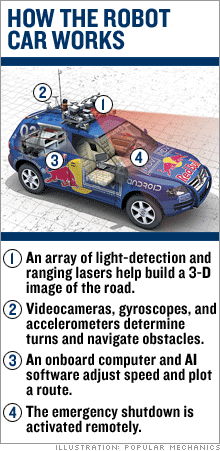Sick of driving? This robot car takes the wheelA 39 year-old Stanford professor thinks he's built the Model T of self-driving cars, reports Business 2.0 Magazine.(Business 2.0 Magazine) -- "Leave the driving to us" was a clever slogan for Greyhound buses - but Sebastian Thrun foresees a day when it'll work for the auto industry. The 39-year-old Stanford professor of electrical engineering is the world's most successful manufacturer of self-driving vehicles: He and his graduate students built Stanley, the first car to complete the DARPA Grand Challenge, a 131-mile robot car race across the desert near Las Vegas organized by the research arm of the Pentagon.   That historic success in 2005 netted Thrun a $2 million prize. He reinvested some of it in an even more intelligent Stanley, which will be unveiled at the next iteration of the robot car contest - one that takes place on city streets. Obstacles include stop signs, lights, and cars driven by humans. Thrun is confident that Stanley is the Model T of self-driving cars. "It might take 20 years, but people said we would never fly massive numbers of people over the Atlantic," he says. "There's an enormous waste of productivity in commuter traffic. We could increase the capacity of highways with precision driving." That means the auto industry gets to sell us more cars, not to mention safer ones - there were 43,443 U.S. highway fatalities in 2005, and Thrun thinks self-driving vehicles, equipped with cameras and motion sensors and all networked with one another, could reduce that number by 50 percent. Not convinced? Take a look at the current crop of cars with increasingly automated functions. The 2007 Mercedes S-Class can tighten your seat belt and close windows if it senses an imminent accident. The 2007 Lexus LS 460 can virtually parallel-park itself at the press of a button, a trick borrowed from the Japanese version of the Toyota Prius (see "Drivers Optional"). Adaptive cruise control on the 2006 Acura RL senses when another vehicle is too close and applies pressure on the brakes to slow you down. Such new models are removing the necessity for human control - which, some Detroit executives say, is what we want. "Say you're blazing up to a busy intersection, fumbling around with your BlackBerry, and the light turns red," says Mark Chernoby, vice president for engineering at DaimlerChrysler (Charts). "Your car could know, and either warn you to stop or stop for you." Lane changing is another repetitive task ripe for automation: Forward-looking radar devices and rear-vision cameras could make it a push-button process. As for the networking infrastructure, the FCC has already set aside a chunk of the wireless spectrum so cars can communicate with one another and be calibrated remotely. Once the pieces are in place, the trucking industry would likely be the first beneficiary. Unmanned delivery vehicles could follow predetermined routes the way robotic vehicles already do inside a warehouse. Thrun and Chernoby say a fully automated highway is possible by 2025. If Stanley can successfully navigate those city streets this fall, we will be a step closer to stepping away from the steering wheel. ____________________________________________ More from the latest issue of Business 2.0 Magazine: 101 Dumbest Moments in Business Jeff Hawkins hacks the human brain Madison Avenue's do-it-all startup Bionic bodies: We have the technology |
Sponsors
|
